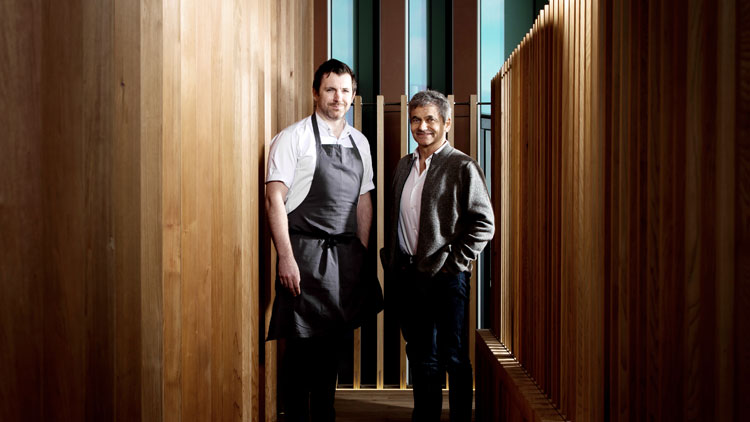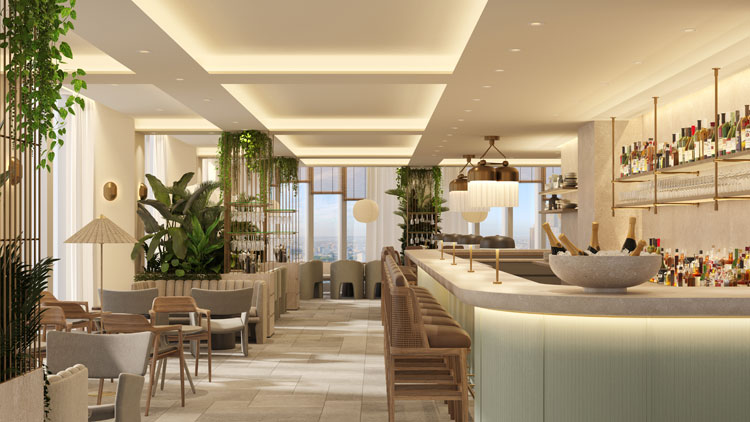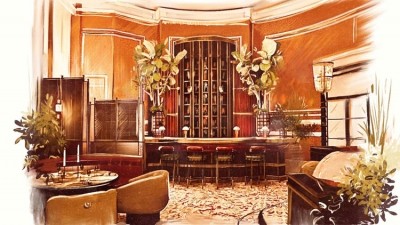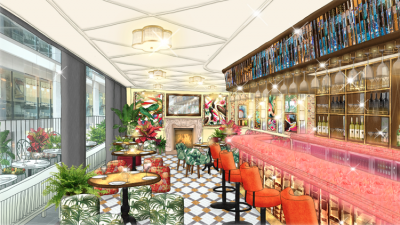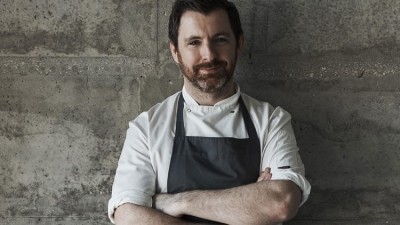Way out East: Patrick Powell and Harry Handelsman on bringing some Chiltern Firehouse glamour to Stratford
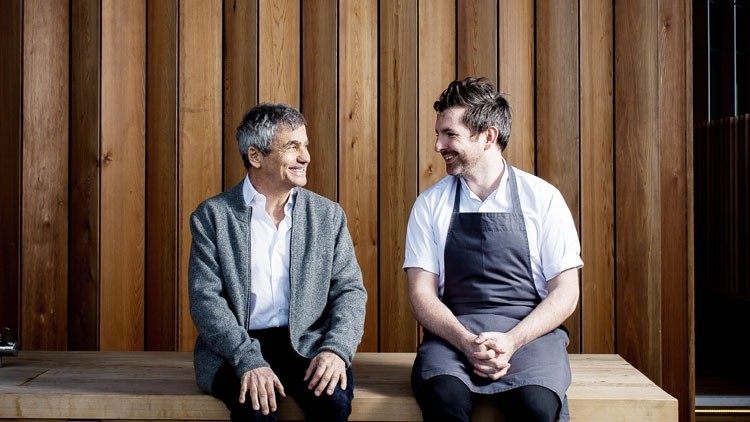
There is a theory among some restaurant critics that the quality of the view from a restaurant is in inverse proportion to the quality of the food on the plate. Thus, high-rise restaurants with striking panoramic views over an urban sprawl or riverside pubs often disappoint in the culinary stakes – after all, customers will forgive almost anything if they’ve got something nice to look at, or so the theory goes.
If you were to follow this logic then the food at Allegra, the soon-to-open restaurant at the newly-built Manhattan Loft Gardens in Stratford, will be stunning, solely based on the fact that the views from the seventh floor restaurant are far from awe-inspiring. Out of one window guests can look at an empty raised level car park, positioned next to a piece of scrubland being used as a temporary builder’s yard, while out of another the view is of the large loading bay that services Westfield Stratford City shopping centre. The top of the Eiffel Tower this ain’t.
“Normally people in a restaurant at this level look outwards, but they will most certainly be looking in,” jokes Patrick Powell, Allegra’s head chef. “We’re having to make the place look really nice to compensate for what is a pretty terrible view.”
It’s not just the view that many of Allegra’s guests may find lacking; the location itself is also a bit of an eyebrow-raiser. The impressive 42-storey skyscraper, which is home not only to Allegra, but a ground floor brasserie, the six-storey, 145-bedroom The Stratford hotel and the 34-storey The Stratford Lofts, would look more at home in a salubrious part of the capital than opposite Stratford International train station and to the rear of an east London shopping mall and is thus out of step with much of its local surroundings. So what’s going on?
Lofty ambitions
It’s all down to Manhattan Loft Gardens owner Harry Handelsman. As founder and CEO of Manhattan Loft Corporation, Handelsman has form in pitching up in less obvious London locations and breathing life into them. He is credited with making Clerkenwell cool when he converted an abandoned art deco printworks into 23 open-plan loft apartments, and then doing the same in King’s Cross by restoring and reopening the St Pancras Renaissance Hotel at a cost of £200m.
More recently, Handelsman, along with hotelier André Balazs, took The Ivy’s crown as the celebrity hangout du jour when they opened Chiltern Firehouse in one of London’s oldest fire stations in Marylebone, transforming the once quietly sophisticated area into a buzzy melting pot of glitz and glamour. With Stratford, Handelsman is hoping he once again has the magic touch.
But Stratford. Really? It’s one thing to take on a beautiful building in a central London location and sprinkle some (albeit very expensive) fairy dust on it, it’s quite another to build a whacking big modern skyscraper in a part of town that has seen massive flux due to the creation – and then dismantlement – of an Olympic village, and which is now best known for being home to a huge shopping centre and West Ham’s new football ground. It’s also hard to envisage Victoria Beckham or Jennifer Lawrence – or indeed any of Chiltern Firehouse’s glamorous clientele – avoiding the 2am paparazzi flashbulbs after a night in Stratford.
Yet Handelsman is sanguine about all this, saying he has merely moved from a 19th century challenge (the 10-year renovation of the Grade 1-listed St Pancras) to a 21st century one (which has also been a 10-year undertaking). In Stratford’s case, the more incongruous the building the better. Manhattan Loft Gardens and its flagship restaurant Allegra is a statement of intent, a intentional break from the norm.
“Developers are risk averse, because why take risks?” says Handelsman, looking relaxed in one of the building’s smart and spacious apartments. “Shareholders want to go to established areas. If they are prosperous areas they build nice blocks. In less prosperous areas they build less nice and more affordable blocks. When I first came to Stratford in 2008, you could see the high rises coming up. With expectations of the Olympics, people wanted to build affordable high-rise living and put Westfield shopping centre next to it. Unfortunately, that becomes a premise and the neighbourhood becomes
an extension of that. The Olympics were amazingly well planned but now here we are in a car park in the heart of Stratford with nothing allocated for it, which is the most bizarre thing. The planners at first didn’t want a build of this quality here.
“The way one changes a neighbourhood is by being brave to create something different – once you change it and are successful, hopefully people emulate that. People move because of what becomes available.”
This isn’t about elitism, he insists, but about bringing a new element to Stratford. “I don’t want to create a bourgeois high-rise building, I want Stratford to be like any other neighbourhood in London. It should be mixed with the more affordable and the less affordable, with something that has status. I want to introduce something that is pretty spectacular and unique to the area.
“It’s a gift to Stratford. I’m not saying that in a condescending way, but just that people deserve more decent places to stay and eat.”
Changing the London landscape
Handelsman was initially approached to build a hotel in Stratford in time for the Olympics but says he wasn’t interested. Only after visiting the area did he come up with the idea of trying to create a vertical community distinct from standard high-rise blocks.
Not only does the split between a hotel and apartments mean the building attracts different lengths of occupancy, it has been designed so that no room has a balcony. Instead, the building has three communal ‘sky gardens’ designed to encourage people to interact with one another.
“The idea behind the development is to build a high-rise community so people don’t just live in an apartment and go to work but can function and interact with their neighbours. I’ve seen many high-rise buildings opening up in central London, which in my opinion really spoils the cityscape. They are so uninspirational – you live in a space and nothing else. I felt it was time to change all of that and make
high-rise living more exciting than just a view. It was an opportunity to introduce something that doesn’t currently exist.”
The hospitality elements of the building are integral to this vision. Rather than a traditional hotel lobby, the entrance to the hotel is via its ground floor Stratford Brasserie, a bright space whose kitchen is being overseen by former Soho House and Gordon Ramsay at Claridge’s chef Ben Harrington. Open all day, the brasserie will have a lunchtime pizza offer, with an outdoor wood oven, as well as salads and small plates and a traditional brasserie dinner menu featuring the likes of schnitzel, risotto and burgers as well as a whole roast chicken.
Then there’s Allegra, accessed by a private lift on the seventh floor, which comprises a 70-cover dining room as well as a large terrace and garden. “People will only come if you populate it with the right amenities that make it desirable,” says Handelsman. “I wanted an amazing lobby where people could gather and meet, so it’s an active brasserie that is fun and exciting. It needs to be a place where east Londoners can hang out until early in the morning. Everything is shifting from central to east; it’ll be the place to be.”
Destination Stratford
And so to Allegra, the restaurant that Handelsman is hoping will act as the glue for the building and as a beacon that will attract Londoners from far and wide. The inspiration for Allegra is an unlikely one, given its high-rise location, but the restaurant takes some of its cues from The River Café, a place Handelsman holds in high regard. Powell, he says, was the obvious choice, with the Ireland-born chef having worked at Chiltern Firehouse for the past fours years.
“I wanted to think about what we could bring to east London,” says Handelsman. “There are some fantastic restaurants here; Cornerstone is just down the road, but they feel more local. I wanted something that makes it a destination, and to achieve that I had to find the right chef, someone who has got the experience and skill but doesn’t yet have their own place. I could have approached someone like [Alain] Ducasse but it would have been just another restaurant for him. I wanted someone young and bright to head it up.”
Powell certainly fits this description. Having trained under Derry Clarke at Dublin’s Michelin-starred L’Ecrivian, he went on to work under Anthony Demetre at Wild Honey before joining Chiltern Firehouse. Working with chef-patron Nuno Mendes as head chef, he was instrumental in its success and reputation for not only being a top celebrity hangout but a place where you could experience brilliant cooking.
However, things could have been very different. Powell says he ended up at Chiltern Firehouse by accident when he went to help out for a couple of weeks and had also been looking to leave and start his own restaurant before the idea for Allegra came up. “Every investor I spoke to just wanted to roll out a concept and open one, and then in two years open another, and in five years have 10, and then we’ll all be rich,” he cites as the reason behind his fruitless search. “It shows you how soulless central London has gone in terms of opening restaurants.”
Handelsman’s plans for Allegra couldn’t be more different, which is why it was attractive. “To be involved in a project like this, which is essentially a passion project, and a very big one at that, is pretty amazing. The best thing about it is the level of ambition around the whole thing.”
As such, Allegra has a lot riding on it, something that Powell is well aware of. “My favourite thing is that it is in Stratford –whatever we do has to be that little bit better because people need to come to us. If this was in central London it would be easier to fill. When we first open people are going to come here, the building’s unbelievable, but that’s not enough to keep it full. We have to be a little bit better than everyone else. It’s cool to be part of something like that. Hopefully we can build a legacy from it.”
Fun rather than glamorous
While it might share its ambitions in being a destination restaurant, Allegra isn’t going to be a copy of Chiltern Firehouse. “Chiltern Firehouse is about glamour, this is more about hospitality,” says Handelsman. “Although I think it will be glamorous eventually.”
Allegra (which take its name from the Italian for ‘joyful’ or ‘lively’) isn’t going to be high concept either. “We spoke a lot about concepts with Space Copenhagen [the interior design company behind Allegra],” adds Powell. “I hate high concept restaurants and I feel London has gone that way – you have to be either this or that concept.”
But, like Chiltern Firehouse, Allegra will be a restaurant that everyone will be talking about – or at least that’s the intention. “We spoke about stripping it back to why do we really go out for dinner?” says Powell. “The whole thing of going to Allegra will be you tell your colleagues, you get dressed up for it, you’re telling people the next day how it was. It’s creating an experience that is more than a just a restaurant and showing everyone a good time. When people come to us they are a gift and we have to look after them so when they leave they can’t wait to come back. That’s our mission statement.”
Needless to say, Powell is taking the food element very seriously. He describes the cooking as modern European and seasonal, with the restaurant sourcing much of its produce from Full Circle Farm in Kent, in which Handelsman has acquired some land. The kitchen will take two deliveries a week, with approximate yields for produce scheduled across the year to give the kitchen an idea of what to put on its menus.
There will be an intensive bread programme and the kitchen will make its own charcuterie, butter and puff pastry as well as do its own in-house butchery. “Everyone appreciates craft, they love a really nice mille-feuille or pithivier. The way the industry is going it’s so hard to find chefs, so there’s a responsibility to train people. And it’s getting harder to find kitchens doing things the right way. If you come and work at Allegra you will learn how to make bread properly, and charcuterie, how to fillet a fish and break down a carcass.”
The restaurant will have different food options; in the main dining room it will serve a regular changing à la carte menu (“I want lots of regulars and for them to see new dishes”) with dishes to include mackerel tartare with salted cucumber, buttermilk and apple; grilled asparagus with crab; and suckling pig with swede cake, peanut, mustard fruit and sage. It will also do sharing dishes, including whole roast chickens and ducks that will come in two servings. “As a customer I love it when you get a second round of food that you weren’t expecting, it feels like it’s free.”
The cooking will be technical, with Powell drawing on his training in French cuisine, but approachable. “I love technique but I don’t like to challenge people, all food should be delicious. Chefs who feel they need to challenge customers are assholes. People are paying money to enjoy something. I have spoken to all the team and the brief with any dish is to sit down and say ‘fuck, that’s delicious.”
Allegra will also serve an eight-course tasting menu derived from the à la carte “for people who want to try a few more dishes and have a longer dinner but not sit down for three hours,” and a bar menu serving items such as oysters, charcuterie and salads. The large outside terrace, covered by an impressive cedar cantilevered roof, has a herb garden and a six-metre grill that in warmer months will become the kitchen’s meat section. The idea is for people to come for lunch, move around the various spaces and potentially stay for dinner, or come for dinner and make a night of it.
“It’s quite a large space so to say we will just do lunch and dinner is a shame. We’re not going to aggressively turn tables, we’ve got lots of space so people can move around. When guests come here we want to keep them all night, it’s that kind of place. Plus there’s nowhere else to go around here.”
Being able to do this makes operational sense too, he adds. “If people stay all day then they will spend more and reduce the number of covers needed, which puts less pressure on the kitchen and makes it easier to produce better dishes.”
Learnings from the Firehouse
At 70 covers and with numerous spaces, Allegra is a big undertaking, so Powell’s experience at Chiltern Firehouse will be invaluable. He admits he had reservations when moving from the diminutive Wild Honey, when it was in Mayfair, to the 100-cover Chiltern Firehouse but soon changed his tune.
“The best thing [about Chiltern Firehouse] is the kitchen is completely open, you are essentially in the dining room and the energy in that room every single night was pumping. Working in restaurants doesn’t get any better than that. That is the end goal for Allegra. If I can stand in the restaurant and see that everyone is enjoying themselves, that’s when we’ve won.”
Unfortunately for Powell, the main kitchen is one floor below the dining room (guests can get a glimpse of it as well as the charcuterie room on the way to the bathrooms) with the food being transported via dumb waiters, so he won’t be able to experience the buzz from the pass – a pastry section is in the dining room. The kitchen brigade, which will be between 15-18 strong (“depending on how good they are”), will however benefit from having a lot of natural light thanks to the large windows that provide the aforementioned views over Stratford.
He’s also a fully signed up member of the large restaurant brigade having done his time at Chiltern Firehouse. “I’d rather do 140 covers than 40 – 40 covers is boring, the room would be dull. You can do 240 covers and nothing gets diluted in terms of the final product, you just need more chefs, a bigger kitchen and better equipment. You just think bigger.”
Is he nervous about anything with Allegra? “The one thing I’m worried about is people having to walk through the ground floor brasserie to come to Allegra.”
And what about Handelsman? Given that you’re only ever as good as your last project, is he worried he won’t be able to emulate his previous successes? “The challenge is Stratford, there’s no doubt about it. The building is so incongruous. But we can make it work. Is it predictable? No. Do I expect it to be absolutely successful? Yes.” Could Stratford’s time be now?
This is a web version of an article that first appeared in the June issue of Restaurant magazine, the leading title for the UK's restaurant industry. For more features, comment, interviews and in-depth analysis of the restaurant sector subscribe to Restaurant magazine here.
